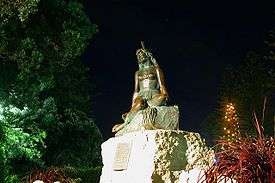Pania

Pania, often styled "Pania of the Reef", is a figure of Māori mythology, and a symbol of the New Zealand city of Napier. A statue of Pania on Napier's Marine Parade is a major local tourist attraction.
The legend of Pania of the Reef
Pania of the Reef was a beautiful maiden who lived in the sea on the east coast of the North Island of New Zealand. By daylight she swam about with creatures of her reef world but after sunset would go to a stream that ran into the bay where the city of Napier now exists. She would travel up the stream to an area where she could rest among the flax bushes. Karitoki, the very handsome son of a Māori chief, quenched his thirst every evening at the stream where Pania rested because it had the sweetest water. He was unaware she was observing him for many weeks until one night she whispered a faint spell. It carried on the wind to Karitoki who turned around to see Pania emerge from her hiding place.

Karitoki had never seen someone so beautiful and instantly fell in love. Pania fell in love also, and they pledged their lives to each other and were secretly married. Pania and Karitoki went to his whare (house), but because it was dark no-one saw them enter. At sunrise, Pania prepared to leave but Karitoki tried to stop her. She explained that as a creature of the ocean, when the sirens of the sea called her each morning, she could not survive if she did not go to them. She promised to return every evening and their marriage continued on that basis.
Karitoki boasted to his friends about his beautiful wife, but no one believed him because they had never seen her. Frustrated by this, Karitoki consulted a kaumatua (wise elder) in the village who believed Karitoki as he knew ocean maidens did exist. The kaumatua told Karitoki that being a sea creature, Pania would not be allowed to return to the sea if she swallowed cooked food.
That night, as Pania slept, Karitoki took a morsel of cooked food and put it in Pania's mouth. As he did so, Ruru the morepork (owl) called a loud warning and Pania was startled from her sleep. Horrified that Karitoki had put her life in jeopardy, Pania fled from the whare and ran to the sea. Her people came to the surface and drew her down into the depths as Karitoki swam frantically about the ocean looking for her. He never saw her again.
When people now look deep into the water over the reef, some say they can see Pania with arms outstretched, appealing to her former lover. It is unknown whether she is imploring him to explain his treachery, or expressing her continuing love.
The sea off Napier is now protected by Moremore, the son of Pania and Karitoki. He is the kaitiaki (guardian) of the area, a taniwha (spirit) who often disguises himself as a shark, a stingray or an octopus.
The Napier statue

A 1.5 metre statue of Pania was unveiled at Napier's Marine Parade on 10 June 1954 by then Prime Minister Sidney Holland, and has since been much photographed by tourists.
The statue was commissioned by members of the Thirty Thousand Club after the Anglican Bishop of Aotearoa, Frederick Augustus Bennett, related the legend of Pania to them. Several students from Hukarere Girls College were photographed as models for the statue, and eventually, Mei Irihapiti Robin (now Mei Whaitiri), was selected. A clay likeness of the photograph of Mei and an actual traditional Piupiu skirt were made by the Italian Marble Company of Carrara in Carrara, Italy. The clay model was then used to produce the bronze statue, which is estimated to weigh between 60 and 70 kg.
The statue has often been compared to the Little Mermaid statue in Copenhagen; there is a resemblance between the two figures, both statues are small, bronze, and near the ocean, and both are based on similar stories.
Vandalism and theft
In 1982, the statue was shot in the head.[1] The damage was later repaired.
Then, on 27 October 2005 the statue was stolen.[2][3] Police were unsure of the motive but thought activism unlikely, a prank unlikely because theft was premeditated, and theft of the bronze for meltdown was unlikely because it was worth only about NZD$200. They thought a ransom was possible because a statue worth $250,000 earlier stolen from a restaurant in Waikanae was returned after $10,000 ransom was paid.[4] Pania was discovered by Jeff Foley and recovered by police on November 4,[5] restored, then replaced on November 16.
See also
References
- ↑ Hawke's Bay Today article
- ↑ "Iconic bronze statue stolen from Napier tourist spot". The New Zealand Herald. NZPA. 27 October 2005. Retrieved 1 November 2011.
- ↑ NZPA and Rebecca Walsh (28 October 2005). "Napier still in shock over theft of Pania". The New Zealand Herald. Retrieved 1 November 2011.
- ↑ "Sculpture returned after ransom paid". One News. 18 October 2005. Retrieved 1 November 2011.
- ↑ Recovery of the statue (Stuff.co.nz article)
External links
| Wikimedia Commons has media related to Pania. |